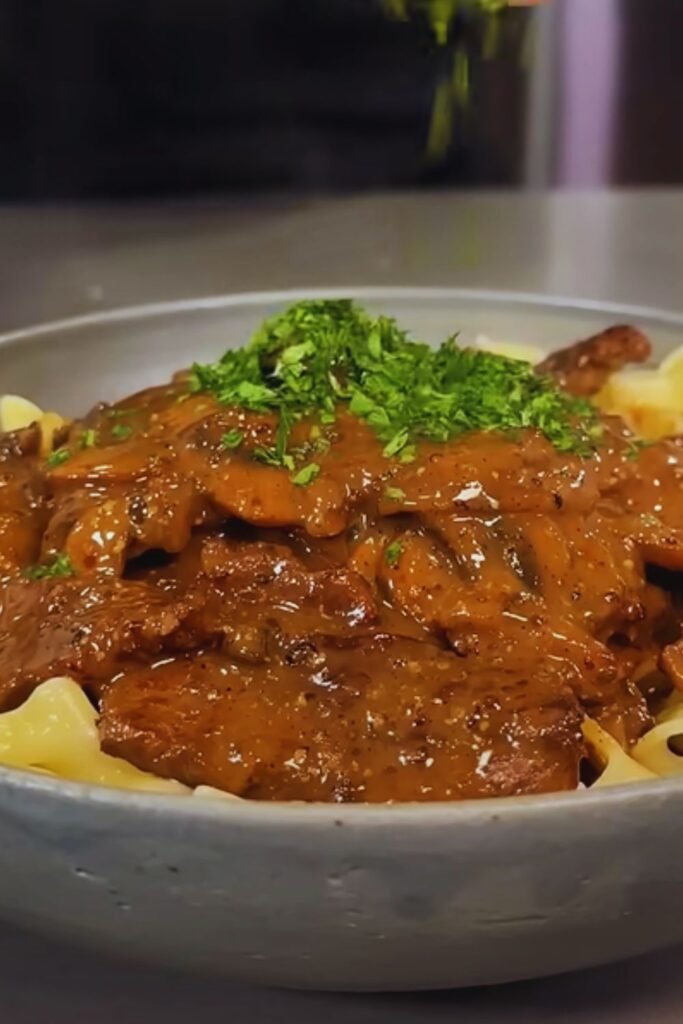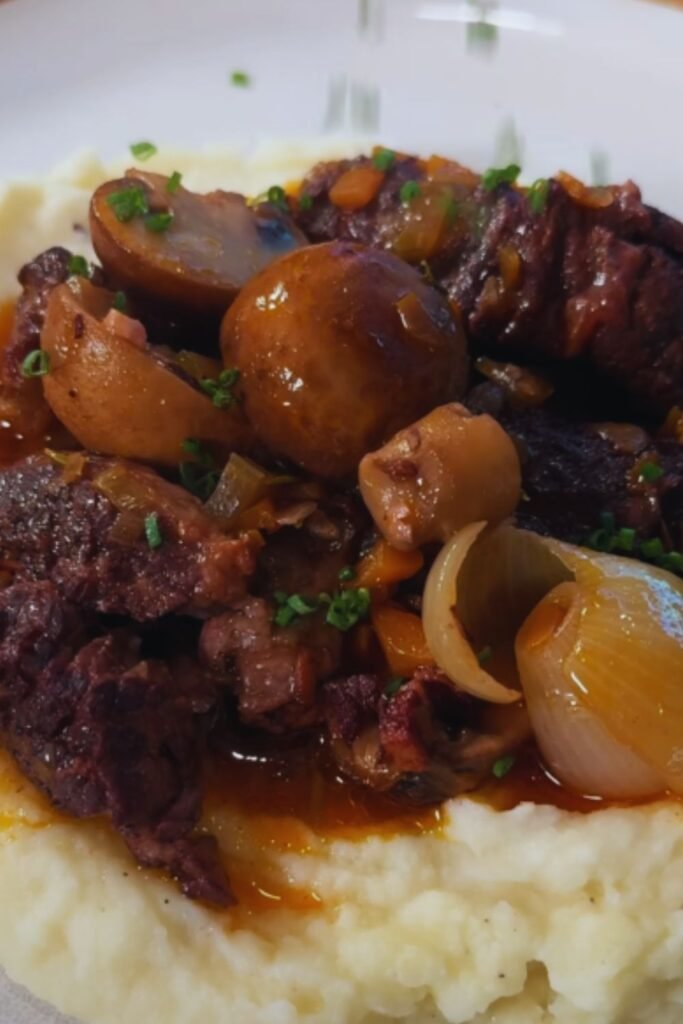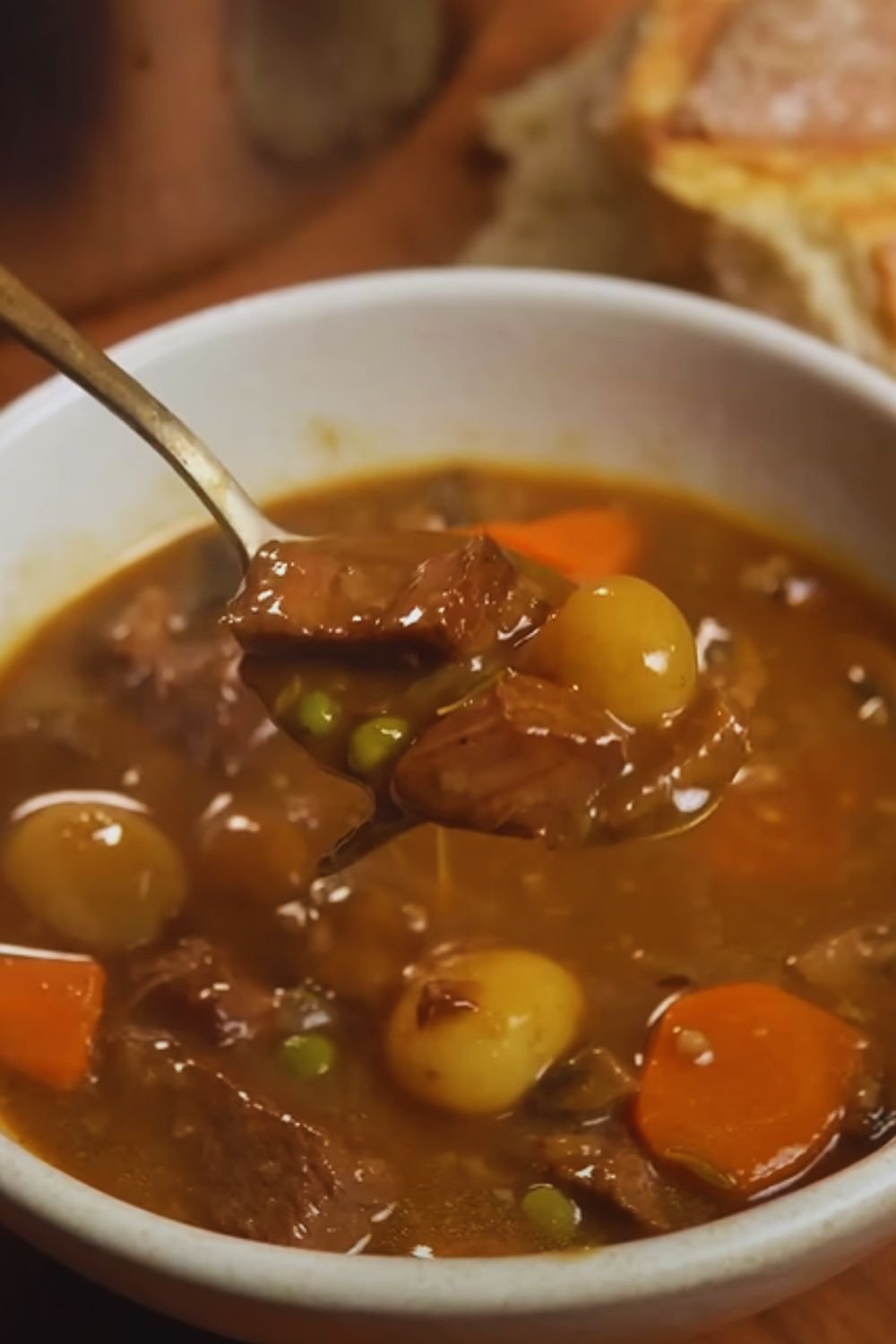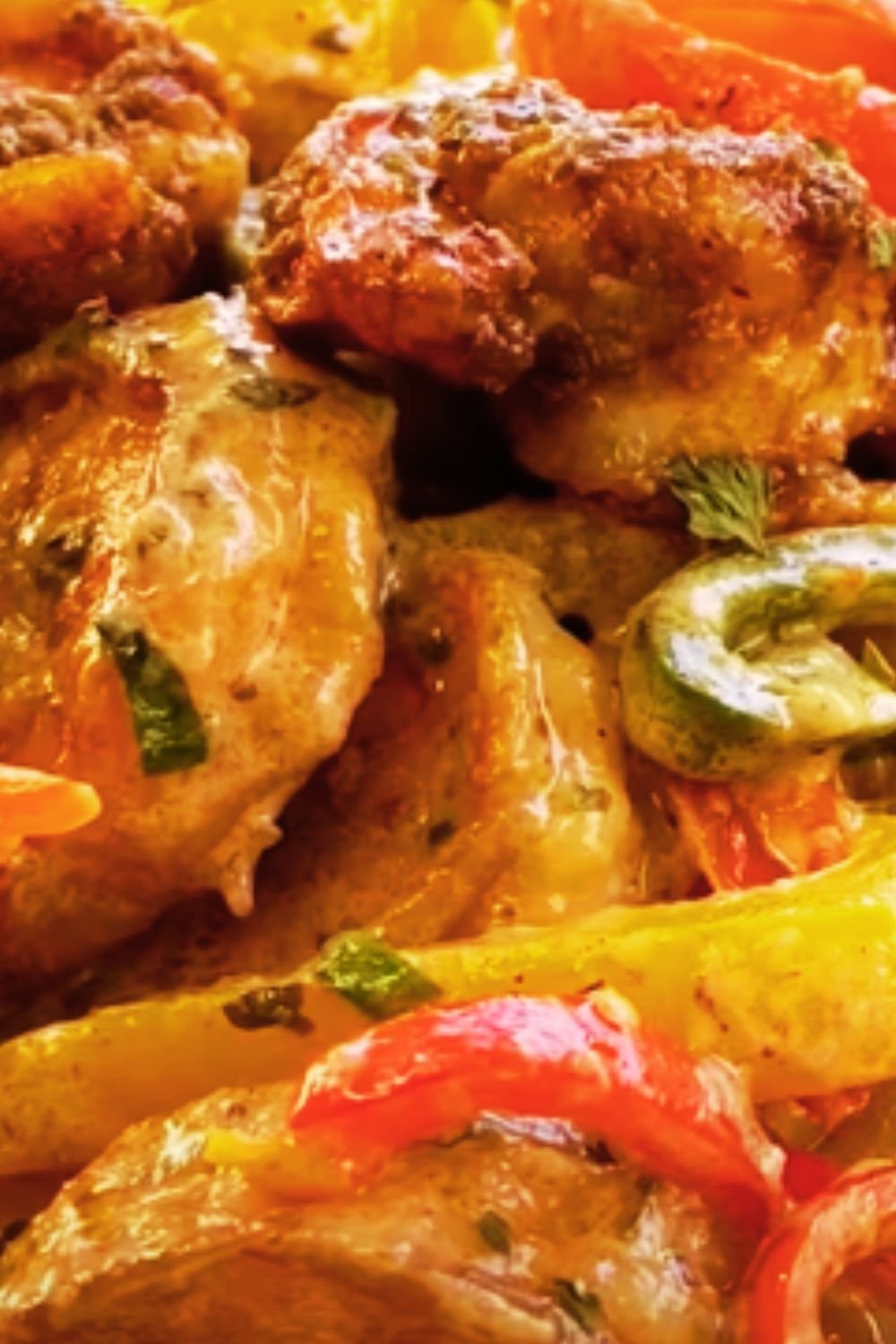There’s something magical about a pot of beef stew simmering on the stove. The rich aroma that fills your home, promising warmth and satisfaction with every spoonful. I’ve been perfecting my beef stew recipe for years, and today I’m excited to share my ultimate version with you. This isn’t just food—it’s a hug in a bowl, the kind of meal that creates memories around the dinner table.
The History Behind the Comfort
Beef stew has been warming souls for centuries. I first fell in love with this dish when my grandmother would make it on cold winter Sundays. The beauty of beef stew lies in its humble origins—peasants across Europe would slow-cook tough cuts of meat with whatever vegetables were available, transforming simple ingredients into something extraordinary through time and patience.
What fascinated me most as I researched stew traditions is how nearly every culture has their version. From the French Boeuf Bourguignon to Hungarian Goulash to Irish Stew—the foundation remains the same: tough meat, transformed through slow cooking into tender morsels in a rich, flavorful broth.
Why This Recipe Works
Before diving into the recipe, I want to share why this particular method creates the best beef stew you’ll ever taste:
- The meat browning technique develops a deep flavor foundation
- Deglazing the pan captures every bit of caramelized goodness
- Low and slow cooking breaks down collagen in tough cuts
- Strategic vegetable addition ensures perfect texture for each component
- Balanced seasoning creates layers of flavor without overwhelming the palate
I’ve made beef stew hundreds of times, and through trial and error, I’ve identified the critical steps that take this dish from good to unforgettable. Trust me—the extra attention to detail is worth it.
Ingredients That Make the Difference

One of the most important lessons I’ve learned is that quality ingredients matter tremendously in a dish this simple. Here’s what you’ll need:
The Main Components
- 2½ pounds chuck roast, cut into 1½-inch cubes
- 2 tablespoons vegetable oil
- 2 medium onions, roughly chopped
- 3 cloves garlic, minced
- 2 tablespoons tomato paste
- 1 tablespoon Worcestershire sauce
- 3 cups beef stock (homemade if possible)
- 1 cup red wine (optional, replace with additional stock if preferred)
- 1 bay leaf
- 1 teaspoon dried thyme (or 3 sprigs fresh)
- 1 pound Yukon Gold potatoes, cut into 1-inch pieces
- 4 carrots, peeled and cut into 1-inch pieces
- 3 celery stalks, cut into 1-inch pieces
- 8 ounces cremini mushrooms, quartered
- 1 cup frozen peas
- ¼ cup fresh parsley, chopped
- Salt and freshly ground black pepper
Special Additions for Flavor Depth
- 1 teaspoon anchovy paste (trust me, it’s secret umami—no fishy taste)
- 1 tablespoon brown sugar
- 2 tablespoons all-purpose flour
Let’s talk about the meat: Chuck roast is my go-to cut for stew. It has the perfect balance of meat, fat, and connective tissue that, when cooked slowly, creates tender morsels and contributes to a silky, rich broth. If chuck isn’t available, look for beef labeled “stew meat,” shoulder, or round—though chuck will give you the best results.
I firmly believe that homemade beef stock elevates this dish significantly, but a good-quality store-bought stock will work fine. If using store-bought, look for low-sodium versions so you can control the salt level yourself.
Equipment You’ll Need
The right tools make all the difference when preparing beef stew:
- Dutch oven or heavy-bottomed pot: The even heat distribution is crucial
- Sharp chef’s knife: For precise cutting of meat and vegetables
- Wooden spoon: For scraping up those flavorful browned bits
- Measuring cups and spoons: For accurate ingredient proportions
- Kitchen twine: If creating an herb bundle
I’ve tested this recipe in various pots over the years, and nothing beats a heavy cast-iron Dutch oven. The way it retains and distributes heat ensures perfect browning and simmering. If you don’t have one, any heavy-bottomed pot will work, but you might need to adjust heat levels more carefully.
The Step-by-Step Process
Phase 1: Building the Foundation
- Pat the beef cubes dry with paper towels and season generously with salt and pepper.
- Heat 1 tablespoon oil in your Dutch oven over medium-high heat until shimmering.
- Working in batches (about 3), sear the beef on all sides until deeply browned (about 3-4 minutes per batch). Avoid overcrowding the pan, which causes steaming instead of browning.
- Transfer browned meat to a plate and repeat with remaining beef.
- Reduce heat to medium and add the remaining tablespoon of oil to the pot.
- Add onions with a pinch of salt and cook until softened and slightly browned (6-8 minutes).
- Add garlic and cook until fragrant (about 30 seconds).
- Stir in tomato paste and cook until it darkens slightly (about 2 minutes).
- Sprinkle flour over the mixture and stir for 1-2 minutes.
Phase 2: Creating the Stew Base
- Pour in wine (if using) and scrape up all browned bits from the bottom of the pot.
- Allow wine to reduce by half (about 5 minutes).
- Add beef stock, Worcestershire sauce, anchovy paste, brown sugar, bay leaf, and thyme.
- Return beef to the pot along with any accumulated juices.
- Bring to a simmer, then reduce heat to low, cover, and cook for 1½ hours, stirring occasionally.
Phase 3: Incorporating Vegetables
- Add potatoes, carrots, celery, and mushrooms to the pot.
- Return to a simmer, cover, and cook for another 45-60 minutes, until vegetables and meat are fork-tender.
- Stir in frozen peas and cook for an additional 5 minutes.
- Remove bay leaf and thyme sprigs (if used).
- Stir in chopped parsley.
- Taste and adjust seasoning with salt and pepper as needed.
I’ve found that adding the vegetables later in the cooking process prevents them from becoming mushy while still allowing them to absorb the stew’s flavors. The staggered cooking approach ensures every component is perfectly cooked.
The Science Behind a Perfect Stew
Understanding the science behind beef stew has helped me refine my technique over the years:
| Process | Scientific Effect | Cooking Impact |
|---|---|---|
| Meat browning | Maillard reaction creates hundreds of flavor compounds | Develops deep, complex flavors |
| Slow cooking | Collagen converts to gelatin | Creates tender meat and silky broth |
| Deglazing | Dissolves fond (browned bits) | Captures concentrated flavors |
| Flour addition | Gelatinization of starch | Thickens broth without clumping |
| Vegetable timing | Controlled breakdown of cell walls | Perfect texture in each vegetable |
The Maillard reaction during meat browning is non-negotiable for developing flavor. When proteins and sugars on the meat’s surface are exposed to high heat, they create hundreds of new flavor compounds. This is why I insist on taking the time to brown the meat properly in batches.
Troubleshooting Common Stew Issues
Even experienced cooks encounter challenges with beef stew. Here are solutions to common problems:
Meat Toughness Issues
- Problem: Meat remains tough after cooking
- Solution: Continue cooking longer. Tough meat means collagen hasn’t fully broken down into gelatin yet.
Broth Problems
- Problem: Broth is too thin
- Solution: Create a slurry with 1 tablespoon cornstarch and 2 tablespoons cold water. Stir into simmering stew and cook for 5-10 minutes.
- Problem: Broth is too thick
- Solution: Add beef stock ¼ cup at a time until desired consistency is reached.
Flavor Balance
- Problem: Stew tastes flat
- Solution: Add a splash of vinegar or Worcestershire sauce to brighten flavors.
- Problem: Stew tastes too acidic
- Solution: Add ½ teaspoon sugar to balance acidity.
I’ve encountered all these issues at different times, and these solutions have never failed me. Remember that stew is forgiving—most problems have simple fixes!
Serving Suggestions

A proper beef stew deserves the right accompaniments. Here are my favorite ways to serve this hearty dish:
- Fresh crusty bread or buttered dinner rolls for sopping up broth
- A simple green salad with vinaigrette to cut through the richness
- Creamy mashed potatoes as a base (for the ultimate comfort food experience)
- Steamed rice for a different textural experience
- Roasted garlic polenta for an Italian-inspired twist
I personally prefer a thick slice of sourdough bread with a generous spread of salted butter alongside my stew. The contrast between the crusty bread and rich stew creates the perfect bite.
Make-Ahead and Storage Tips
One of the beauties of beef stew is that it gets better with time. Here’s how to make the most of this characteristic:
Make-Ahead Options
For best flavor development, consider these approaches:
- Complete early: Make the entire stew a day ahead, refrigerate overnight, and reheat gently before serving. The flavors will meld beautifully.
- Partial preparation: Complete through Phase 2, refrigerate, and finish with vegetables the next day.
Storage Guidelines
| Storage Method | Duration | Special Instructions |
|---|---|---|
| Refrigerator | 3-4 days | Cool completely before refrigerating; reheat gently |
| Freezer | Up to 3 months | Freeze without potatoes for best texture; add fresh when reheating |
| Reheating | – | Add splash of broth if needed during reheating |
I often make a double batch specifically to freeze individual portions for quick weeknight meals. The stew freezes beautifully, though potatoes can become slightly grainy after freezing. If planning to freeze, consider slightly undercooking the vegetables.
Variations to Try

While my classic recipe is time-tested, these variations offer delicious alternatives:
International Inspirations
- French-Style: Add 8 ounces pearl onions and replace thyme with a bouquet garni. Use burgundy wine for deglazing.
- Irish-Style: Use Guinness stout instead of wine, add 1 tablespoon caraway seeds, and include parsnips with the vegetables.
- Hungarian-Style: Add 2 tablespoons paprika with the tomato paste and include bell peppers with the vegetables.
Dietary Adaptations
- Gluten-Free: Replace flour with 2 tablespoons cornstarch mixed with cold water, added during the last 30 minutes of cooking.
- Low-Carb: Substitute turnips or radishes for potatoes and increase mushroom quantity.
- Extra Hearty: Add ½ cup barley with the beef (requires additional cup of stock).
I regularly rotate these variations into my meal planning to keep this classic dish exciting year-round. The Hungarian-style version, with its rich paprika flavor, has become a particular favorite in my household during the colder months.
Nutrition Information
For those monitoring nutritional intake, here’s the approximate breakdown per serving (based on 6 servings):
| Nutrient | Amount | % Daily Value |
|---|---|---|
| Calories | 485 | – |
| Protein | 38g | 76% |
| Fat | 23g | 35% |
| Carbohydrates | 28g | 9% |
| Fiber | 5g | 20% |
| Sodium | 580mg | 24% |
| Iron | 6mg | 33% |
| Potassium | 1240mg | 35% |
This stew provides an excellent balance of protein and complex carbohydrates with a moderate fat content. It’s particularly rich in B vitamins, iron, and zinc from the beef, while the vegetables contribute significant fiber, potassium, and vitamins A and C.
A Note on Sustainability
I’ve become increasingly conscious of the environmental impact of beef production. If this is a concern for you too, consider:
- Purchasing beef from local farms that practice regenerative agriculture
- Reducing overall meat consumption by making this stew less frequently but enjoying it fully
- Experimenting with recipes that use half the beef and double the mushrooms for a more sustainable option
These small choices can make a difference while still allowing us to enjoy traditional recipes.
Why This Recipe Has Become My Signature Dish
I’ve served this stew at countless family gatherings, taken it to potlucks, and delivered it to friends in need of comfort. Without fail, people request the recipe. What makes it special isn’t just the technique or ingredients—it’s the love and attention that goes into making something truly nourishing.
Food has always been my way of showing care, and few dishes communicate that sentiment better than a carefully prepared beef stew. It says, “I value you enough to spend hours creating something that will bring you comfort and joy.”
Questions and Answers
Q: Can I make this in a slow cooker instead of the stove?
Yes! Brown the meat and vegetables as directed, then transfer everything to a slow cooker. Cook on low for 7-8 hours or high for 4-5 hours. Add the peas during the last 30 minutes.
Q: What’s the best cut of beef for stew if I can’t find chuck roast?
Look for beef labeled as “stew meat” or cuts from the shoulder or round. The key is finding meat with good marbling and connective tissue that will break down during slow cooking.
Q: Can I skip the wine in this recipe?
Absolutely. Simply replace it with an equal amount of additional beef stock. You might want to add a tablespoon of vinegar (balsamic or red wine vinegar) to replace some of the acidity that wine provides.
Q: My stew never seems to get thick enough. What am I doing wrong?
There are several possible issues: you may need more flour in the initial cooking stage, your simmer might be too gentle to reduce the liquid, or you might need to cook it uncovered toward the end to allow for more evaporation. You can also make a cornstarch slurry as described in the troubleshooting section.
Q: How can I add more vegetables while keeping the rich flavor?
Feel free to add more vegetables like turnips, parsnips, or bell peppers. Just be mindful of their cooking times—add firmer vegetables with the potatoes and carrots, and quicker-cooking ones later with the peas.
Q: Is there a way to make this recipe more budget-friendly?
Yes, you can use less meat and more vegetables, particularly beans or lentils which add protein and heartiness. Also, watch for sales on chuck roast and freeze it until needed.
Q: Why do you recommend adding the vegetables later rather than at the beginning?
Adding vegetables later prevents them from overcooking and becoming mushy. Each vegetable has its optimal cooking time, and staggering their addition ensures everything is perfectly cooked.
Q: Can I make this beef stew spicy?
Definitely! Add red pepper flakes with the garlic or a diced jalapeño with the vegetables. You could also stir in a spoonful of harissa paste or gochujang for complex heat.
There’s something deeply satisfying about serving a pot of homemade beef stew on a cold evening. The way faces light up at the table, the appreciative silence as everyone takes their first bite, the request for seconds—these moments make the time investment worthwhile.
I hope this recipe brings as much joy to your table as it has to mine over the years. Remember that cooking is as much about feeding the soul as it is about nourishing the body. Enjoy the process, make it your own, and most importantly—share it with people you love.


